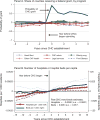The War on Poverty's Experiment in Public Medicine: Community Health Centers and the Mortality of Older Americans
- PMID: 25999599
- PMCID: PMC4436657
- DOI: 10.1257/aer.20120070
The War on Poverty's Experiment in Public Medicine: Community Health Centers and the Mortality of Older Americans
Abstract
This paper uses the rollout of the first Community Health Centers (CHCs) to study the longer-term health effects of increasing access to primary care. Within ten years, CHCs are associated with a reduction in age-adjusted mortality rates of 2 percent among those 50 and older. The implied 7 to 13 percent decrease in one-year mortality risk among beneficiaries amounts to 20 to 40 percent of the 1966 poor/non-poor mortality gap for this age group. Large effects for those 65 and older suggest that increased access to primary care has longer-term benefits, even for populations with near universal health insurance. (JEL H75, I12, I13, I18, I32, I38, J14).
Figures









Similar articles
-
A New Community Health Center/Academic Medicine Partnership for Medicaid Cost Control, Powered by the Mega Teaching Health Center.Acad Med. 2018 Mar;93(3):406-413. doi: 10.1097/ACM.0000000000001901. Acad Med. 2018. PMID: 28930763
-
Community health centers: medical homes for children?Acad Pediatr. 2013 Sep-Oct;13(5):436-42. doi: 10.1016/j.acap.2013.06.006. Acad Pediatr. 2013. PMID: 24011746
-
The effect of a poverty reduction policy and service quality standards on commune-level primary health care utilization in Thai Nguyen Province, Vietnam.Health Policy Plan. 2010 Jul;25(4):262-71. doi: 10.1093/heapol/czp064. Epub 2009 Dec 28. Health Policy Plan. 2010. PMID: 20038572
-
Community Health Centers and Access to Care Among Underserved Populations: A Synthesis Review.Med Care Res Rev. 2020 Feb;77(1):3-18. doi: 10.1177/1077558719848283. Epub 2019 May 13. Med Care Res Rev. 2020. PMID: 31079529 Review.
-
Social Security's special minimum benefit.Soc Secur Bull. 2001-2002;64(2):1-15. Soc Secur Bull. 2001. PMID: 12428507 Review.
Cited by
-
The impact of long-term care insurance on healthcare utilization and expenditures among middle-aged and older Chinese adults: a quasi-experiment study.Int J Equity Health. 2024 Oct 14;23(1):211. doi: 10.1186/s12939-024-02297-y. Int J Equity Health. 2024. PMID: 39402560 Free PMC article.
-
Is the Social Safety Net a Long-Term Investment? Large-Scale Evidence From the Food Stamps Program.Rev Econ Stud. 2024 May;91(3):1291-1330. doi: 10.1093/restud/rdad063. Epub 2023 Jun 8. Rev Econ Stud. 2024. PMID: 39281422 Free PMC article.
-
Evaluating the health outcomes of aging in place: the role of medicaid aging waiver program on U.S. older adults.BMC Public Health. 2024 Aug 5;24(1):2104. doi: 10.1186/s12889-024-19498-3. BMC Public Health. 2024. PMID: 39103811 Free PMC article.
-
Chronic diseases and determinants of community health services utilization among adult residents in southern China: a community-based cross-sectional study.BMC Public Health. 2024 Mar 28;24(1):919. doi: 10.1186/s12889-024-18435-8. BMC Public Health. 2024. PMID: 38549080 Free PMC article.
-
Assessing the impact of public insurance on healthcare utilization and mortality: A nationwide study in China.SSM Popul Health. 2024 Jan 26;25:101615. doi: 10.1016/j.ssmph.2024.101615. eCollection 2024 Mar. SSM Popul Health. 2024. PMID: 38322784 Free PMC article.
References
-
- Adashi Eli, Geiger H Jack, Fine Michael D. Health Care Reform and Primary Care—The Growing Importance of the Community Health Center. New England Journal of Medicine. 2010;362(22):2047–50. - PubMed
-
- Almond Douglas, Chay Kenneth, Greenstone Michael. MIT Department of Economics Working Paper 07-04. 2006. Civil Rights, the War on Poverty, and Black-White Convergence in Infant Mortality in the Rural South and Mississippi.
-
- Almond Douglas, Hoynes Hilary W, Schanzenbach Diane Whitmore. Inside the War on Poverty: The Impact of Food Stamps on Birth Outcomes. Review of Economics and Statistics. 2011;93(2):387–403.
-
- American Hospital Association (AHA) Annual Survey of Hospitals. Chicago: AHA; 1948–1990.
-
- Arellano M. Computing Robust Standard Errors for Within-Groups Estimators. Oxford Bulletin of Economics and Statistics. 1987;49(4):431–34.
MeSH terms
Grants and funding
LinkOut - more resources
Full Text Sources
Other Literature Sources
Miscellaneous

